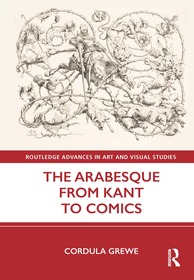
The Arabesque from Kant to Comics
Series: Routledge Advances in Art and Visual Studies;
- Publisher's listprice GBP 39.99
-
19 105 Ft (18 195 Ft + 5% VAT)
The price is estimated because at the time of ordering we do not know what conversion rates will apply to HUF / product currency when the book arrives. In case HUF is weaker, the price increases slightly, in case HUF is stronger, the price goes lower slightly.
- Discount 20% (cc. 3 821 Ft off)
- Discounted price 15 284 Ft (14 556 Ft + 5% VAT)
Subcribe now and take benefit of a favourable price.
Subscribe
19 105 Ft

Availability
Estimated delivery time: In stock at the publisher, but not at Prospero's office. Delivery time approx. 3-5 weeks.
Not in stock at Prospero.
Why don't you give exact delivery time?
Delivery time is estimated on our previous experiences. We give estimations only, because we order from outside Hungary, and the delivery time mainly depends on how quickly the publisher supplies the book. Faster or slower deliveries both happen, but we do our best to supply as quickly as possible.
Product details:
- Edition number 1
- Publisher Routledge
- Date of Publication 26 August 2024
- ISBN 9781032043708
- Binding Paperback
- No. of pages312 pages
- Size 246x174 mm
- Weight 760 g
- Language English
- Illustrations 55 Illustrations, black & white; 21 Illustrations, color; 55 Halftones, black & white; 21 Halftones, color 590
Categories
Short description:
The Arabesque from Kant to Comics tracks the life and afterlife of the arabesque in its surprising transformation from an iconoclastic literary theory of early German Romanticism to aesthetic experimentation in both avant-garde art and popular culture.
More
Long description:
The Arabesque from Kant to Comics tracks the life and afterlife of the arabesque in its surprising transformation from an iconoclastic literary theory of early German Romanticism to aesthetic experimentation in both avant-garde art and popular culture.
Its explosive growth in popularity was followed by an inevitable taming as arabesques became staples in book illustration, poetry publications, and even the decoration of printed scores. The subversive potential of the arabesque was preserved in one of its most surprising offspring, the comic strip: born at the moment when the cholera pandemic first swept through Europe, the comic translated the arabesque’s rank growth into unnerving lawlessness and sequences of contagious visual slapstick. Focusing roughly on the period between 1780 and 1880, this book illuminates the intersecting histories of avant-garde theories of writing, visual culture, and even the disciplinary origins of art history. In the process, it explores media history and intermediality, social networks and cultural transfer, as well as the rise of new and nontraditional art forms.
This book will be of particular interest to scholars of art history, intellectual history, European art, aesthetics, book illustration, material culture, reproduction, comics, and German history.
MoreTable of Contents:
Part I: Three Beginnings 1. Prologue 2. Forays into a Form Grown Wild: Setting the Stage 3. An Outline (of Things to Come) Part II: The Arabesque Revolution: Image, Script, and the Crisis of Representation 4. Metaphysics and Media Crisis 5. The Ornament of the Gaze: On Albrecht Dürer 6. The Divine (as) Parergon 7. Ornament, Allegory, Autonomy: Winckelmann, Lessing, Goethe, Karl Philipp Moritz 8. The Disappearance of a Goddess: On Immanuel Kant’s Parergonality Part III: The Writing on the Wall 9. Art History Painted: Peter Cornelius’s Murals for Munich’s First Picture Gallery, 1827–1840 10. History as Nationalist Vision: Wilhelm Kaulbach’s Murals for Berlin’s Neue Museum, 1847–1865 Part IV: Turning the Page 11. Philipp Otto Runge’s Flypaper: On Intimacy 12. The Poet’s Pencil: On Clemens Brentano and Achim von Arnim 13. Turning the Page: On Eugen Napoleon Neureuther Part V: Taming the Arabesque 14. The Artist as Arabesque: Wilhelm Schadow as The Modern Vasari 15. The Humorous Arabesque: From Wilhelm Schadow to Karl Leberecht Immermann and back, via Johann Baptist Sonderland 16. The Arabesque’s Kingdom: Adolph Schroedter and Theodor Mintrop 17. Illustration as Intervention and Parody: On Julius Hübner Part VI: A Symphonic Intermezzo 18. Beethoven, or the Call for Freedom in Composition: On Moritz von Schwind 19. The Laws of Form: On Seriality and Pictures’ Stories Part VII: A Satirical Finale 20. Contagious Laughter: On Pandemics, the Comics’ Birth, and Rodolphe Töpffer 21. "Ach! Poor Venus is perdue": On Wilhelm Busch 22. The Last Act’s Final Flourish
More




